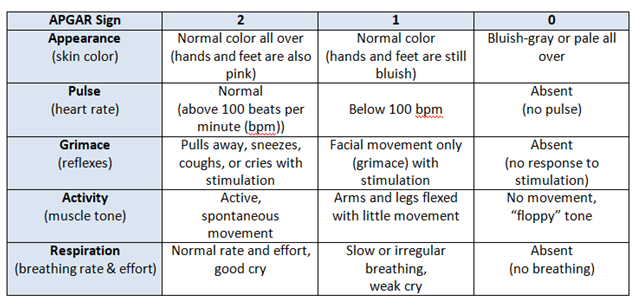A is for APGAR
/APGAR is a test that is performed on your baby twice after birth, at 1 minute and at 5 minutes of life. The tests can be done while you hold your baby as they are merely observations. The score at 1 minute indicates how well your baby tolerated being born and the score at 5 minutes indicates how well your baby is doing now that he/she is outside of the womb. If the scores are poor at 1 and/or 5 minutes the test may be performed again at 10 minutes.
The APGAR test was developed by Virginia Apgar in 1952 and is the standard test used to asses all babies immediately after birth. APGAR stands for Appearance, Pulse, Grimace response, Activity, and Respiration and examines your baby’s skin color, heart rate, reflexes, muscle tone, and breathing rate & effort – each one is scored with a 0, 1, or 2 based on observations. The chart below may help you understand how a score is determined.
APGAR Scoring
The APGAR score ranges from 0 to 10, with 10 being the highest. A score of 7 or above indicates your baby is healthy. 10 is unusual with a score of 9 being most common due to the fact that newborn hands and feet tend to stay blue immediately following birth. If your baby scores below 7 this means your baby needs some assistance with adjusting to being outside of your womb. Low scores may be caused by prematurity, a long or difficult birth, c-section, or fluid in the lungs or airway. The test is preformed twice because more often than not an initial low score is normal at the 5 minute test. A low APGAR score does not mean your child will have health complications or issues as he/she grows up, it is only indicative of how they are doing in that moment.
Were you told your baby’s APGAR score? What was it? Just for fun I scored a 2 for both the 1 minute and 5 minute tests and finally scored a 10 at the 10 minute test.
Next week I will be blogging on the letter B… B is for Bilirubin. In the meantime, check out the other blog series “ABCs of Pregnancy” & “ABCs of Labor and Delivery, and over the next few days I will be posting the initial blog for “ABCs of Postpartum”.


